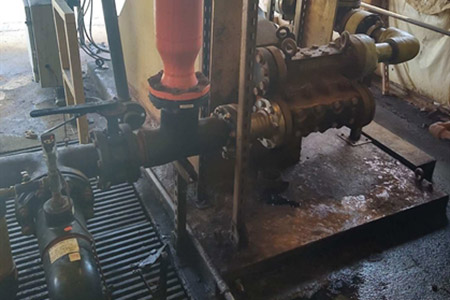Corrosive Liquids
Wanner Hydra-Cell Pro® seal-less pumps ensure 100% containment – protecting your operators and the environment.
With a wide range of materials of construction, including Hastelloy, PTFE, PVDF and FFKM & FKM elastomers, coupled with the seal-less design makes Hydra-Cell pump a reliable option for handling corrosive liquids. Many Hydra-Cell pumps are in service pumping Sulphuric, Hydrochloric, Nitric acids, Deionised water and other corrosive liquids with proven reliable service.
Pumps with dynamic seals pumping corrosive liquids often need expensive seal arrangements and/or seal flushing. The seal-less Hydra-Cell Pro design eliminates these costs, lowering the total cost of ownership.
Wanner Application Briefs
A large electronics manufacturer was having pump problems with their acid regeneration system when they had inconsistent performance and premature failure of their chemical feed pumps. Hydra Cell D10 size acid pumps with variable speed drives would handle the required flow rate of 4-6 GPM (15-23 l./min). Hydra-Cell Pro acid pumps were installed to adjust the pH levels of the process fluid by dosing in acid or caustic as required. Hastelloy and Viton XT were selected for the sulphuric acid, and stainless steel acid pumps fitted with EPDM were selected for the sodium hydroxide. Due to the corrosive nature of the process solutions, the end user required the acid pumps be fitted with ANSI flanged connections for the inlet and outlet ports. This custom feature is available in stainless and alloy D10, H25, and D35 acid pumps from Wanner. Manifolds ports are socket welded with full penetrate welds on all weld neck flanges and elbows.
A precision machine shop specializing in STEM (Shaped Tubular Electro Machining) manufacturing used for "drilling" high tolerance holes that conform to curved profiles. The hole follows a curved path and can reach "depths" of 18 inches (46 cm). This tight tolerance work is more of a "guided machining" process rather than actual drilling.
The machine shop uses special titanium tubes with an insulated coating for creating these holes. Warm sulphuric acid (15-19%, 100°F, 38°C) is pumped through these tubes at 75 psi (5 bar) to dissolve the alloy. A strong electric current charges the tip of the tube to accelerate the process. The tube never actually comes in contact with the part maintaining tight tolerances in these curvy holes. The tolerances are checked by x-ray to verify that the hole is being formed correctly. Acid formulation, tube feed rate, and other variables are precisely controlled for the various alloys being machined. While this is a relatively expensive way to machine parts, it is the only way to manufacture some of the complex parts used in turbines and jet engines.
As the acid consumed the metal, the conductivity of the acid changes and as such cannot be reused. In the past, small quantities of the acid were neutralised and hauled away for disposal. As acid usage increased along with the cost of treatment and disposal, it became necessary to install a membrane filter system to reclaim the acid. As much as 90% of the acid can be reused utilizing this on-site system. The filter system was originally supplied with a multi-stage centrifugal pump. The pump immediately developed leaks and frequent repairs (with different seals) proved fruitless. The intermittent duty cycle with long periods of down time proved fatal for the multi-stage pump.
Frustrated, the OEM of the filter system reviewed the situation and suggested a Hydra-Cell Pro acid pump model H25EFTGTTTTB. The Hastelloy and Viton XT pump is directly driven at 1160 RPM and delivers 20 GPM (76 l./min) at a variable pressure of 350-490 PSI (24-34 bar). The crew at the machine shop has confidence in the filter system operation and increased its usage to maximise acid reclamation and reduce the amount of new acid purchased. The Hydra-Cell Pro acid pump is at the heart of this acid reclamation system and has paid for itself many times over.

For companies that generate aqueous waste, deep-well injection is a cost effective and environmentally sound method of disposal. Liquid wastes, in this case (Hydrochloric, Nitric & Sulphuric Acids, are received from clients and stored in above-ground tanks. After analysis, chemical treatment and filtering, the wastes are transferred through the facility’s piping system to one of two fully permitted Class 1 injection wells.
For this customer, the previous pump could not reliably handle the aggressive chemical mixes used, leaking the hazardous liquids which posed a very serious threat locally and cost the company $100,000 to $140,000 every 4-6 months in repair costs. Hydra-Cell Pro seal-less and packing-free pumps have since been installed, proving 100% leak-free operation - safeguarding staff and the environment.
We can help
Wanner’s technical engineers can assist you in selecting a Hydra-Cell Pro seal-less pump to reliably handle your most challenging process liquids.
- Low NPSH due to High vapour pressure?
- Need assistance or support with NPSH in terms of system design?
- Are you replacing other pump technologies for abrasive/slurry duty application?
- Our technical engineers can assist with selecting a Hydra-Cell seal-less pump to reliably handle your process liquid.
